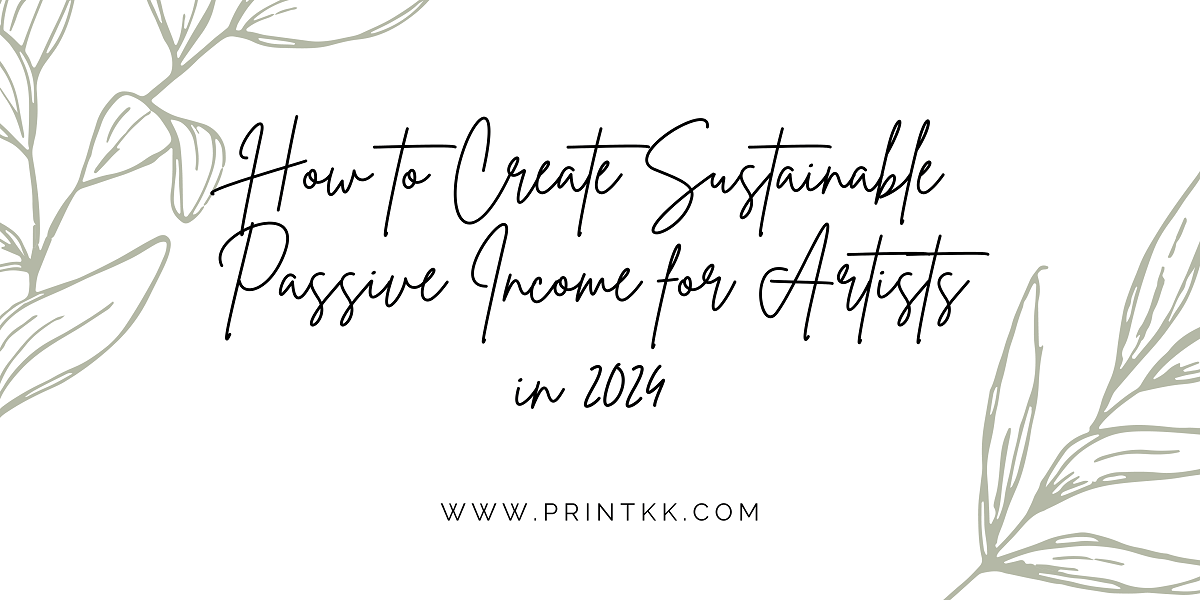
In a world where creativity meets opportunity, artists are finding innovative ways to turn their passion into sustainable earnings. The year 2025 marks a pivotal moment for creatives everywhere to embrace the potential of passive income streams. From leveraging digital platforms to exploring new marketplaces, this blog will guide you through the essential steps to unlock financial freedom and ensure your art continues to work for you, long after you've left the studio. Discover the secrets to building a resilient income source that nurtures your creativity and empowers your artistic journey.
What Is Passive Income?
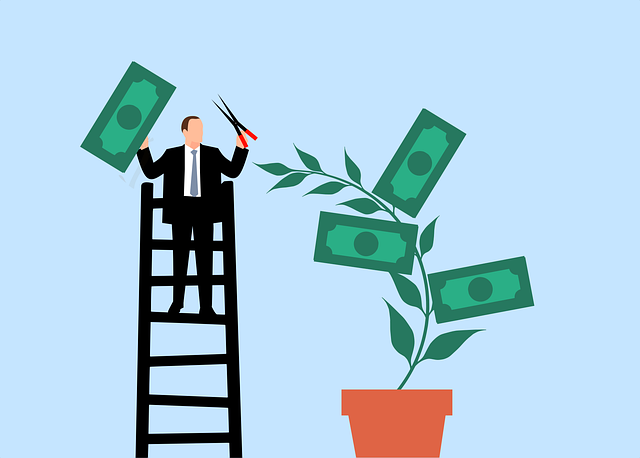
In the vibrant landscape of modern entrepreneurship, the concept of passive income emerges as a beacon of opportunity, particularly for the creative minds of artists and designers. This financial strategy is not just a buzzword but a transformative approach to building wealth without the continuous, active effort typically demanded by traditional jobs. But what exactly is passive income, and how does it relate to the artistic community?
Passive income is defined as earnings derived from an enterprise in which a person is not actively involved on a day-to-day basis. For artists, this could mean revenue generated from licensing their work, selling digital copies of their art, or earning from print-on-demand services, where their designs are printed on a variety of products, from apparel to home decor, and sold without the artist needing to manage inventory or fulfill orders. This model allows creators to focus on their passion—crafting art—while also securing a financial stream that supports them beyond the sale of original pieces.
The allure of passive income for artists lies in its promise of financial freedom and the ability to sustain a living while pursuing creative endeavors. It's a strategy that caters not only to individual artists but also to small business owners, designers, brands, influencers, corporations, and organizations looking to diversify their income sources. By leveraging their creative assets, these entities can create a sustainable revenue model that thrives on the initial effort invested in creating a piece of art or design, reaping the benefits long after the work is done.
In essence, passive income for artists is about turning creative output into a renewable resource that continues to generate earnings. It represents a shift from trading time for money to making one's art work smarter, not harder. For the entrepreneurial artist, it opens up a realm of possibilities for financial stability and growth, allowing them to dedicate more time to their craft while also building a robust income stream that supports their artistic and financial goals.
Why Should You Make Passive Income?
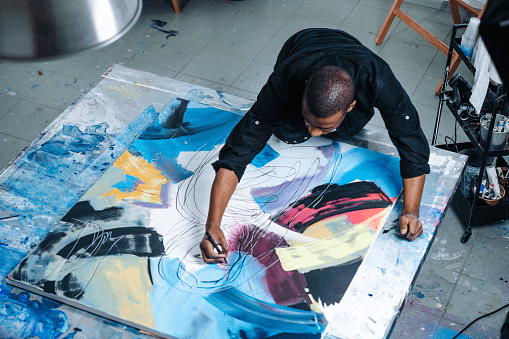
Embracing the concept of passive income offers a multitude of advantages, especially in the dynamic realms of art and design. For creators navigating the challenges of financial stability while pursuing their passion, the allure of generating income passively is too significant to overlook. But why exactly should artists and designers, along with entrepreneurs, small business owners, and brands, consider integrating passive income streams into their financial strategies?
Firstly, passive income affords the luxury of time. Unlike traditional income, which is directly tied to the hours one works, passive income frees up time, allowing creators to invest in what truly matters: their art, innovation, and personal growth. This shift from trading time for money to earning while one sleeps is not just a financial strategy; it's a lifestyle change. It enables artists to spend more time in the studio without worrying about the next paycheck. For entrepreneurs and small business owners, it means the ability to focus on scaling their businesses rather than being bogged down by day-to-day operations. Brands and influencers can leverage passive income to expand their reach and influence without additional daily effort.
Moreover, passive income streams contribute to financial security and independence. In the unpredictable world of art and business, diversifying income sources can cushion against fluctuations in sales or client work. It offers a steadier, more predictable income flow, crucial for long-term planning and peace of mind. This financial backbone supports not just individual artists but also small businesses and corporations in mitigating risks and seizing opportunities for growth. For those in the print-on-demand sector, it underscores the importance of creating evergreen content and products that continue to sell without constant updates or involvement.
In conclusion, the pursuit of passive income is more than a financial decision; it's a strategic move towards greater freedom, creativity, and stability. It empowers creators and entrepreneurs alike to build a sustainable future, where their work continues to benefit them, allowing them to focus on what they do best. For anyone in the creative field, exploring passive income avenues is not just wise—it's essential for thriving in today's competitive landscape.
Types of Passive Income for Artists
In the evolving landscape of the creative industry, artists have at their disposal a variety of avenues to generate passive income. This diversification not only enhances their financial stability but also empowers them to continue their artistic pursuits with greater freedom and less financial stress. Here, we explore several types of passive income streams that artists, designers, and creative entrepreneurs can tap into, broadening their revenue sources beyond traditional one-time sales.
- Licensing Artwork
- Artists can license their artwork to companies and publishers, allowing them to use the art on products, in advertising, or as part of packaging. This approach provides artists with a continuous income stream from their creations, as they receive a fee or royalty every time their art is used.
- Print-on-Demand Services
- Utilizing print-on-demand platforms enables artists to sell their designs on a wide array of products, from apparel to home decor, without handling inventory or fulfillment. This model allows for earnings on each sale without the upfront costs associated with producing the merchandise.
- Digital Products
- Creating digital products such as ebooks, online courses, or downloadable art provides artists with an income source that requires minimal upkeep once the product is developed. These digital assets can be sold repeatedly, reaching a global audience without additional production costs.
- Stock Photography and Video
- For visual artists specializing in photography or videography, selling work through stock photo and video websites offers a way to earn income from existing content. As businesses and creators continually seek high-quality visual content, this passive income stream can grow over time.
Best Passive Income Ideas for Artists
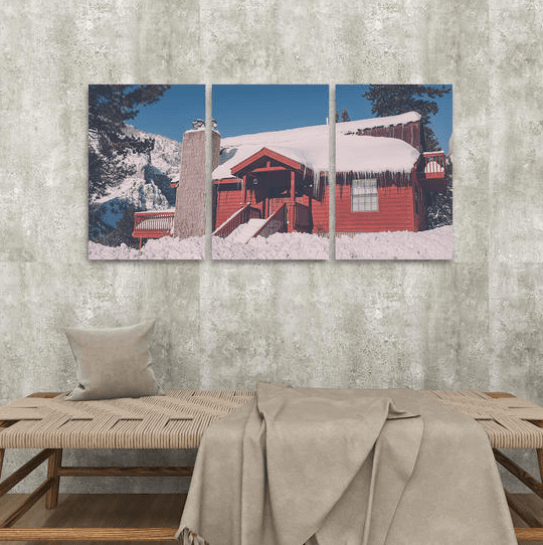
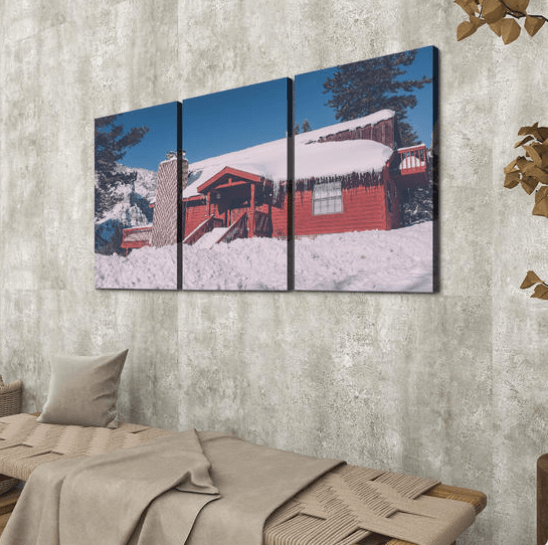
In the realm of creativity, artists have a unique opportunity to harness their skills and artworks to build a sustainable passive income. This not only ensures financial stability but also allows them to continue their artistic endeavors with greater peace of mind. Here, we delve into some of the best passive income ideas that can help artists, designers, and creative entrepreneurs transform their passion into a lasting revenue stream.
- Online Workshops and Courses
- Share your expertise and techniques by creating and selling online courses, catering to aspiring artists and hobbyists seeking to enhance their skills.
- E-books and Guides
- Write and sell e-books or guides on topics ranging from art techniques to navigating the art world, providing valuable insights to both beginners and established artists.
- Art Licensing
- License your artwork to companies for use on products, in advertising, or as part of packaging, earning royalties each time your work is utilized.
- Print on Demand
- Leverage print-on-demand platforms to offer your designs on apparel, accessories, and home decor, earning a profit with each sale without managing inventory.
- Leverage print-on-demand platforms to offer your designs on apparel, accessories, and home decor, earning a profit with each sale without managing inventory.
- Stock Photography
- Sell your photographs to stock photo websites, providing a steady income as businesses and creators use your images for their projects.
- Digital Assets
- Create and sell digital assets like fonts, templates, or design elements to other artists and designers.
- YouTube Channel
- Start a YouTube channel focused on art tutorials, reviews, or day-in-the-life content, monetizing through ads, sponsorships, and memberships.
- Patreon or Membership Site
- Launch a Patreon or membership site, offering exclusive content, behind-the-scenes access, or personalized feedback in exchange for recurring support.
- Affiliate Marketing
- Recommend products, courses, or services you use and love through affiliate marketing, earning a commission for each sale made through your referral.
- NFTs
- Explore the world of digital art and NFTs (Non-Fungible Tokens), selling unique digital artwork on blockchain platforms.
- Art Prints
- Sell high-quality prints of your original artworks online, catering to art lovers who desire your work but at a more accessible price point.
How Do You Passively Sell Art?

In the realm of artistry and creation, the quest for passive income streams has become a pivotal aspect of sustaining a livelihood. Artists, in their pursuit of financial stability without sacrificing their passion or creative integrity, have turned to innovative methods to passively sell their art. This exploration delves into the essence of passive income for artists, unveiling strategies that allow creators to earn while focusing on their craft.
- Digital Platforms and Marketplaces
- Artists have found solace and success in digital platforms, where their creations can reach a global audience without the need for physical presence. Websites like Etsy, Society6, and Redbubble serve as conduits, connecting artists with potential buyers. These platforms not only facilitate the sale of digital prints and merchandise but also offer artists a chance to showcase their portfolio to a wider audience. As one artist, ArtLover123 on Reddit, shared, "leveraging these sites has enabled me to earn in my sleep," highlighting the quintessential passive income dream.
- Licensing and Royalties
- The power of licensing art for use in commercial products, advertising, or media is a lucrative avenue for artists. By granting companies the right to use their work, artists receive royalties, a form of income that continues to pay dividends long after the initial agreement. A Quora user, CreativeMindset, revealed that artists who venture into licensing can see their creations on everything from greeting cards to apparel, providing a steady income stream while retaining copyright over their work.
- Online Courses and Tutorials
- Sharing knowledge and expertise through online courses and tutorials has emerged as a rewarding path for artists. This approach not only diversifies their income but also enhances their reputation and reach. Platforms like Skillshare and Udemy allow artists to create content once and profit from it indefinitely. SketchMaster88 from the Artist Lounge subreddit underscores the dual benefit of this strategy: artists contribute to the creative community while generating passive revenue.
- User Reviews (Selected Excerpts)
- ArtLover123: I've found that using sites like Etsy and Redbubble allows me to earn in my sleep, which is amazing for passive income.
- CreativeMindset's Original Words: Licensing my art has opened doors to seeing my work on products I never imagined, and the royalties provide a steady income.
- SketchMaster88's Original Words: Creating online courses has not only boosted my passive income but also helped me connect with a community of eager learners.
- Special_Dimension_15: I have a print on demand Etsy shop that also offers digital downloads of phone wallpapers. I also published a couple of coloring books through Amazon KDP. Just build up your portfolio and research what works and eventually it will become more passive, you still need to actively create content and promote it to start.
- Ashtar-the-Squid: Comicbooks, illustration work, prints, and some times single art pieces and original drawings from books. I also sell books, drawing and prints on conventions, fairs and markets. And sometimes I participate at gallery shows.
Final Thoughts
In the realm of art and creativity, the journey towards establishing a passive income stream represents a pivotal shift towards financial empowerment and artistic freedom. This evolution allows artists, designers, and creators from all walks of life to transcend traditional barriers, offering a sustainable pathway to pursue their passion with vigor and purpose. As we reflect on the myriad of strategies discussed, from leveraging print-on-demand platforms to exploring digital marketplaces, the underlying message is clear: the opportunities for artists to generate passive income are as boundless as their creativity.
Embracing these opportunities requires a blend of innovation, persistence, and a willingness to explore new horizons. For entrepreneurs, small business owners, and artists alike, the pursuit of passive income is not just about financial gain but about crafting a legacy that resonates with their deepest values and aspirations. It's about creating a body of work that continues to inspire, engage, and contribute to the world, long after the initial brushstroke is laid. In this light, passive income becomes more than a strategy; it's a testament to the enduring impact of creativity.
As we venture forward, let this exploration serve as a catalyst for action and experimentation. The path to passive income for artists is diverse, inviting each creator to find their niche in the vast tapestry of possibilities. Whether you're a seasoned artist looking to expand your revenue streams or a budding entrepreneur at the cusp of your creative journey, the potential for growth and fulfillment is immense. By harnessing the power of passive income, artists can unlock a future where their work not only sustains them financially but also amplifies their artistic voice, leaving an indelible mark on the canvas of the world.
FAQs
How can an artist make passive income?
Artists can create passive income by leveraging digital platforms to sell art, utilizing print-on-demand services for merchandise, licensing artwork for commercial use, offering digital downloads, and creating online courses or tutorials. This approach enables artists to earn revenue without active daily involvement, offering financial stability and the freedom to focus on creating more art.
Can beginner artists make money?
Yes, beginner artists can earn money by showcasing their work on social media, joining print-on-demand platforms, participating in online marketplaces, and selling digital products. These avenues allow emerging artists to reach a wide audience, build their brand, and start generating income with their art.
Is art a good way to make money?
Art can indeed be a lucrative avenue for generating income, especially with the rise of online platforms and print-on-demand services. Artists who strategically market their work and diversify their income streams, such as through digital products, licensing, and online tutorials, can find financial success and fulfillment in their craft.
Do artists make money off streaming?
Artists can indeed earn from streaming, particularly musicians and digital artists who utilize platforms like Spotify, YouTube, and Twitch. While income varies, effective marketing and a strong online presence can significantly increase earnings from streams, making it a viable passive income source for artists.
What are the best passive income sites for artists?
For artists seeking passive income, top sites include Etsy for selling unique art pieces, Society6 and Redbubble for print-on-demand merchandise, Patreon for subscriptions and exclusive content, and Skillshare for teaching art courses. These platforms offer diverse ways to monetize art and reach wider audiences.










 Made in USA
Made in USA


 Global Shipping
Global Shipping


























